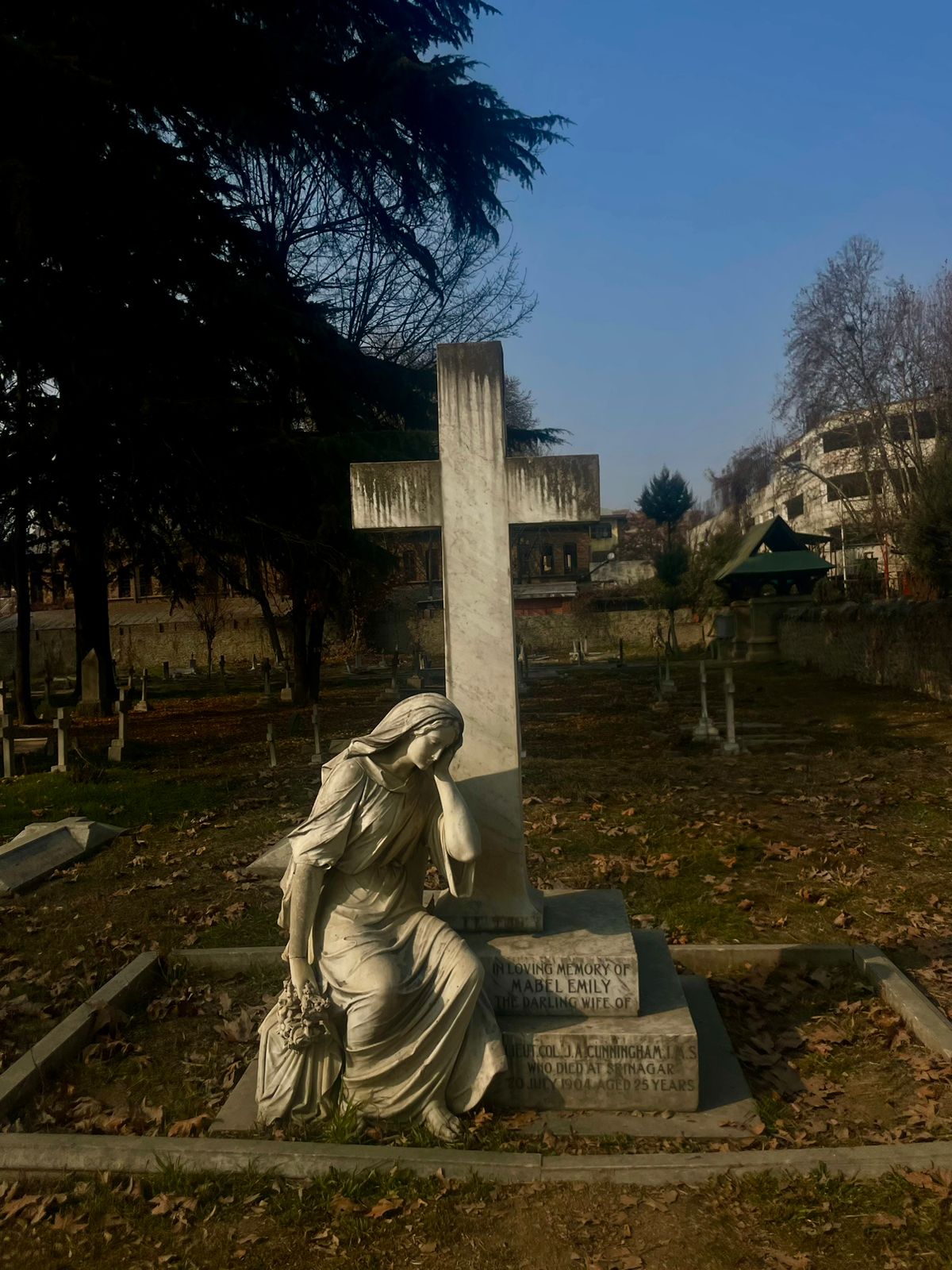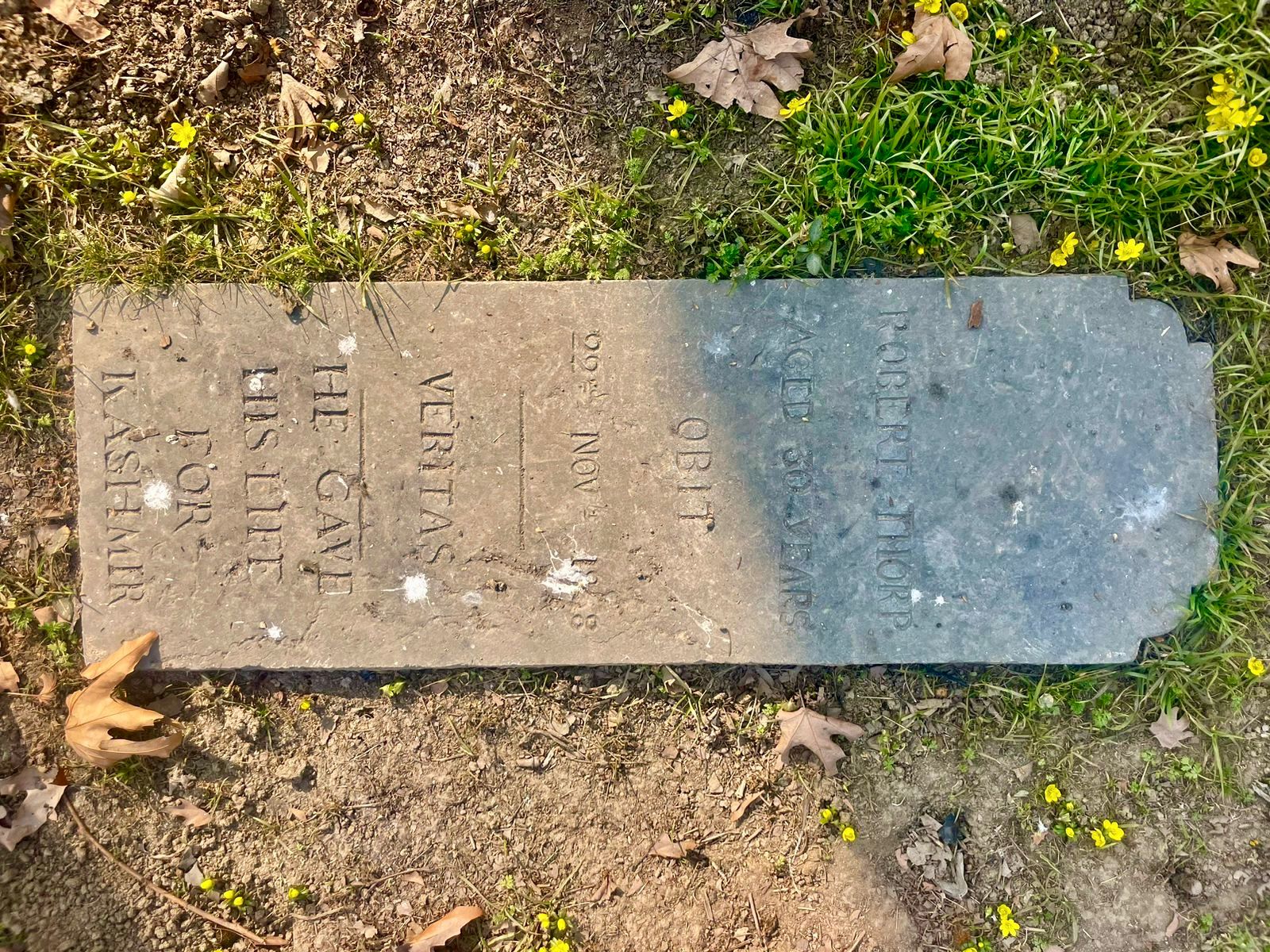A quiet cemetery between Jhelum bund and Lal Chowk’s Ghanta Ghar, girded with tall Chinars, houses the grave of Robert Thorpe, a British military officer whom some historians refer to as the first foreign martyr to have sacrificed his life for this land.
Born in 1838, Thorpe was the son of Colonel Thorpe, who had fallen in love with a local Kashmiri girl named Jan Bibi during his visit to the valley in 1833. Accounts vary; some write Jan Bibi was the daughter of Dayim Rathore, ruler of Kishtwar, while others suggest her origins traced back to the Tosa Maidan region.
When Dogra ruler Ranbir Singh succeeded Gulab Singh in 1857 (to whom British sold Kashmir in 1840’s under British suzerainty fearing Russian takeover of the country) Thorpe arrived in the valley.
During the period, the British were seeking responses of Dogra rule in Kashmir, they encouraged certain locals to provide evidence of mismanagement of the Dogra regime. Kashmiri Pandits, who benefited greatly from Dogra rule, were expected to cooperate, whereas Muslims, largely uneducated, faced challenges in fulfilling this role.
British handed over the assignment to some of their own nationals. These included some missionaries and military officers. Robert Thorpe was one of them, writes Dr. Sheikh Showkat in his book, “The Profiles”.
“Robert Thorpe came to Kashmir, certainly for two reasons, one for his official duty, and second for the love of his mother.”
He explored various parts of Kashmir, but soon his attention became increasingly drawn to the suffering of Kashmiri Muslims. He empathized deeply with their plight under what he considered the most oppressive misrule he had ever witnessed, as noted by Tyndale Biscoe, a reformist of Kashmir education, in his book "Kashmir in Sunlight and Shade."
His keen observations of Kashmir's plight under Dogra rule, reported in his seminal work "Cashmere Misgovernment," brought to light the sufferings of Kashmiri Muslims, exposing oppressive practices: exorbitant taxes, forced labor, and economic monopolies that left communities destitute. Under Ranbir Singh's regime, the state's grip tightened, exploiting Kashmir's resources while depriving its people. Thorpe documented instances of brutality, where dissent was met with draconian punishments and economic exploitation knew no bounds.

S.S. Charak, the author of a book on Maharaja Ranbir Singh, provides a detailed account of Ranbir Singh's reign: “He showed no sympathy toward Kashmiri Muslims or his fellow co-religionists. Instead, he established Sanskrit schools and erected temples across Jammu and Kashmir. The expenses incurred by his father's acquisition of Kashmir—amounting to Seventy-Five Lakh Nanak Shahi Rupees—were extracted from impoverished Kashmiri Muslims through taxes such as temple tax, Sanskrit tax, and others. Even prostitutes and grave diggers faced heavy taxation. The common people were subjected to 'Begaar,' forced labor without pay. For instance, a prostitute named Hafiza was prohibited from changing her profession. Furthermore, taxes were imposed on houses, marriages, cattle, beasts of burden, and grazing, all pushed to their maximum limits.”
“The state imposed taxes of 85% on the shawl industry and 75% on agricultural produce. During harvest seasons, the Maharaja's agents, known as Shakdars, meticulously monitored the crops to prevent farmers from allegedly stealing any portion of their harvest. These agents were notorious for falsely accusing people of crop theft.”
Tyndale Biscoe also writes that the Kashmir Valley experienced famines, leading to severe suffering among Kashmiri Muslims due to the actions of the Maharaja.
“During these times, the Maharaja's officials conducted searches in Muslim households to uncover hidden grains. They closely monitored starving Muslims to prevent them from slaughtering cows, an act punishable by death—where the penalty involved boiling the person in oil and displaying their remains on a pole for vultures to consume. Fishing was also prohibited since Maharaja Gulab Singh's death in August 1857. Brahmins believed at that time that the Maharaja's spirit had transmigrated into a fish in Kashmir, thus the fishing prohibition was enforced.”
This became the focus of Thorp’s attention. The plight of Kashmiri Muslims echoed deeply with Thorpe, compelling him to petition the governments of India and England.
And Thorp started documenting about Ranbir Singh's rule. He wrote about Singh’s agents who harassed Kashmiri Muslims. These agents included the Dum (policeman), Harkara (informer), Tarougdar (revenue official), Shakdar (watchman of crops), Sargowl (head of 10 Shakdars), Kardar (collector of land revenue), Patwari (record keeper of houses and cultivated land), Mukadam (village headman and assistant to Patwari), Thanedar (police officer and magistrate with power to inflict corporal punishment), and, most significantly, the Tehsildar, the officer overseeing a district.
Thorp also documented a historical incident known as "massare," where the Chief of the Shawl Department, Pandit Raja Kakh Dhar drowned 28 shawl workers to death with the governor's support at Zaldagar, Srinagar, on April 29, 1865. These workers had been demanding permission to purchase more rice to feed themselves.
“They were required to work and pay substantial taxes, yet they were simultaneously prohibited from purchasing enough rice to sustain their families,” Thorp documented.
He detailed how taxes burdened every aspect of Kashmiri life—land, fruit trees, beehives, dairy, and local industries. Kashmiri peasants were obligated to fulfill various corvees, often journeying long distances across treacherous mountain passes, as the government's primary income source derived from the land's produce.
Thorp's meticulous analysis, complete with tables, specified that out of the total land produce divided into 32 parts, the government claimed nearly 23 parts. Although the government collected most of its revenue in kind, its actual profits far exceeded what was officially recorded from crop shares.
His writings laid bare the harsh realities faced by the populace, challenging the dogma of colonial authority, exploring topics such as land tenure, revenue administration, taxation of the shawl industry, transportation logistics for military supplies, and the system of forced labor known as Begaar.
The documentation titled 'Cashmere Misgovernment' was published in 1870, two years after he died in 'mysterious circumstances' in Srinagar.
According to historical records, Robert Thorpe was repeatedly ordered by the Maharaja to depart from the Kashmir Valley. However, despite these directives, Thorpe defied the orders and continued to document and denounce the oppressive rule of the Dogras. In November 1868, the Kohi-Suleiman hills in Srinagar witnessed the end of Lieutenant Robert Thorpe.
“One winter morning in 1868, as the sun struggled to rise over the snow-capped peaks, Thorp embarked on a solitary walk towards the revered Shankaracharya hill in Srinagar. It was a journey that would prove to be his last.” Basharat Peer writes in his book, "Curfewed Nights."
“Singh's men, armed with daggers, lay in wait, their sinister intentions unfolding with deadly precision. Thorp fell, his life slipping away on the cold, unforgiving ground.”

To some, Thorpe was a beacon of hope and a savior who courageously challenged the Maharaja's regime. Others viewed him simply as an official of the British Empire, symbolizing colonial power.
However, his death defies easy categorization. His legacy is solemnly inscribed on the tombstone that overlooks his grave in the Christian cemetery of Sheikhbagh, Srinagar. His epitaph declares his life's mission: "He Gave His Life for Kashmir."